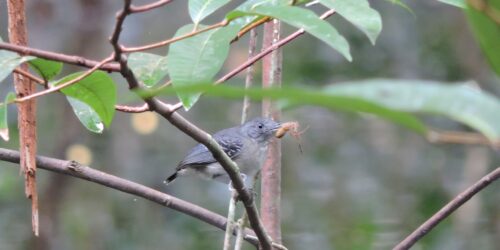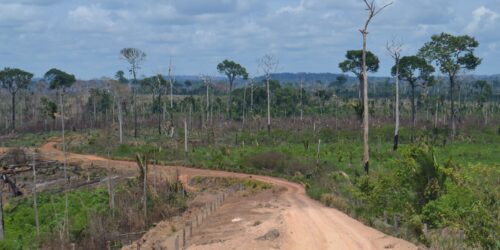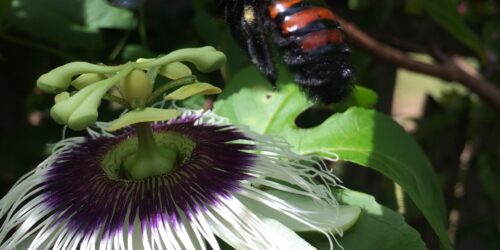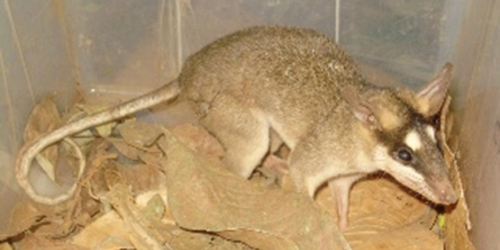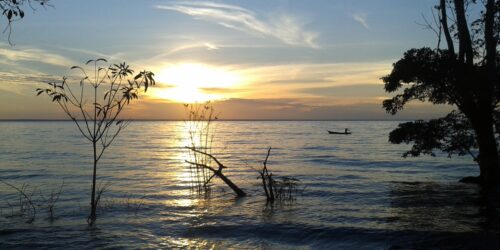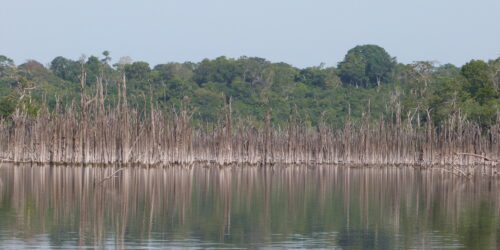The search for snakes in remote areas of the Amazon
5 May 2021 | Duration of reading: 6 min
By Luciana Frazão
T he Amazon is the biggest tropical forest in the world. It is related to the maintenance of several ecosystem services in and outside of the region (e.g. rainfall disponibility in Brazilian South and Southeast), and has an unmeasurable richness of plants, fungi and animal species. The herpetofauna (zoology branch dedicated to the study of reptiles and amphibians) of the Neotropical region, especially the Amazon region, is considered one of the richest in the world. In the Brazilian Amazon alone 189 snake species are known. The species number rises continuously as new locations are accessed and new species are described. While some regions have been thoroughly studied, such as Pará state and the Central Amazon, some sites are still unknown. Thus, the number of existent species must be even higher, in other words, it is currently underestimated, since many Amazon areas are still unexplored either by the difficulty to access them and the low investments in research.

The lack of access to information regarding geographic distribution of species (i.e. where they appear) creates what is defined as theWallacean shortfall”.
The Wallacean shortfall was created in homage to Alfred Russel Wallace (1823-1913), a british naturalist, geographer and anthropologist, also known as the father of zoogeography. In a biome as big as the Amazon many species have characteristics that make their sampling difficult and heighten the Wallacean shortfall, and this happens when approaching snake species.
Tost snake species have cryptic habits (i.e. high camouflage capabilities). Also, snakes are very silent, differently from frogs and birds, for example, that communicate a lot with vocalizations. Snakes do not vocalize, they are masters of sneaking. These characteristics make them difficult to sample in a biome as vast and dense as the Amazon.. Serpentes não vocalizam, ou seja, elas são mestres em passarem despercebidas. Essas características tornam muito difíceis os métodos de amostragem de serpentes, ainda mais em um bioma tão vasto e denso como a Amazônia.
Therefore, fauna surveys or inventories are important tools to create basic knowledge about regional diversity and spatial distribution of species in the Amazon, and are essential to decision making and in the formulation of conservation policies. Thus, we conducted a study that sought to increase the knowledge about geographic distribution and snake species diversity in areas unexplored by researchers. We specifically searched for information regarding community ecology of snakes, such as composition patterns (occurrence of species), richness (number of species), and abundance (estimate of the number of individuals) in different locations
To this end, we accessed six remote locations in the Brazilian Amazon by boat expeditions (see the figure below) that lasted about 30 days for each location. The expeditions were undertaken in the rivers Japurá, Negro, Jatapú, Purus, Trombetas and Tapajós, providing good histories and nice records of snakes.

Map of the study area with the six locations where the Amazon snakes were found.

The expeditions for snake sampling lasted about 30 days and the boat, while being our transport, was also our lodging during the expedition. Purus River, Amazonas. Photo: Sisbiota Project Archives.
We registered a total of 249 individuals and 70 snake species utilizing complementary sampling methods. The jararaca (popular designation for some species of the genus Bothrops), Bothrops atrox (Figure 2), was the commonest in all locations, a pattern already known for the Amazon biome. Among the rarest species we found a false coral snake - Pseudoboa martinsi (figure below) - which was the first record of this species in the Santa Isabel region of Negro river, Amazonas (location nº 2 on the map). Besides known species we registered three subjects of species we couldn’t identify, even being specialists in herpetology and consulting specialized literature. Could this be a new species? We have to investigate further to be sure.

The most abundant snake species in the surveyed areas is the jararaca-do-norte, Bothrops atrox Bothrops atrox. Photo: Luciana Frazão
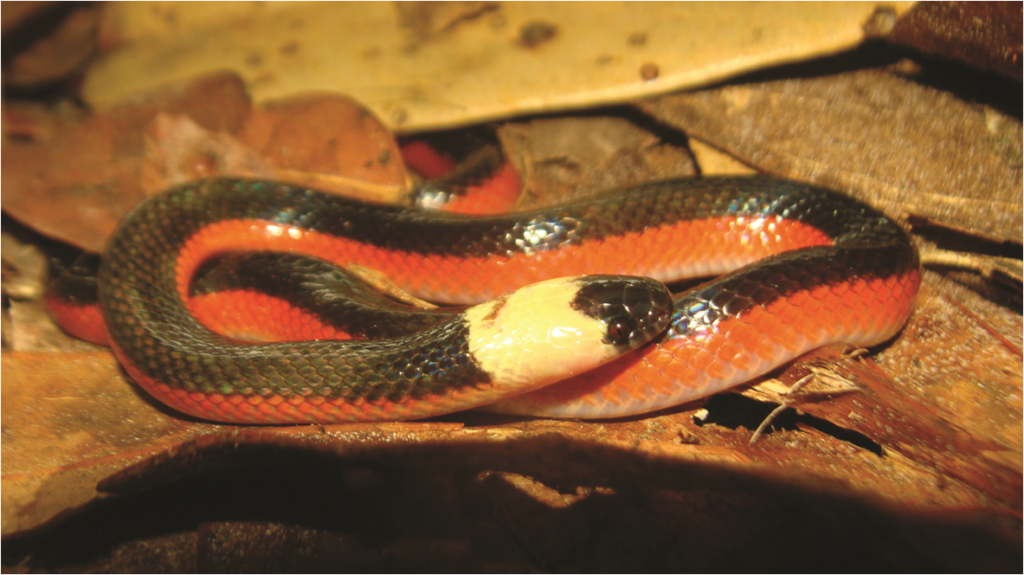
Among rare species we registered a false coral snake, Pseudoboa martinsiduring the research, being this the first record of this species in the Santa Isabel region of Negro river, Amazonas. Photo: Luciana Frazão
Different groups of snakes in each of the surveyed areas showed a variation in species composition. This indicates a strong heterogeneity in snake assemblage in the Amazon with a high substitution of species indicated by specific analysis, in other words, no group of snakes is similar to groups from other areas. However, it is important to consider that this high rotativity of species is partly related to de difference of species richness between the sampled areas, and also can be related to the broad spatial scale of our study - which implies in a great variation of environmental characteristics from each location, and therefore, also implies a species variation.
Our research expanded the knowledge regarding the Amazon herpetofauna. After visiting six locations we registered 37% of known species of the Brazilian Amazon. Without a doubt, there is a high potential to discover and describe new species considering that we registered rare snakes and subjects that still are in the phase of identification, possibly being from new species. Furthermore, our results highlight the importance of standardized surveys of fauna in areas little sampled in the Amazon biome. With that we could obtain more information about patterns of geographic distribution (reducing the Wallacean shortfall) and about the diversity of these animals that are so fascinating.
Science is done collaboratively
Results presented in this text are part of the researched undertaken by Luciana Frazão during her PhD in the Programa de Pós-Graduação em Biotecnologia e Biodiversidade da Amazônia Legal - PPG BIONORTEat the Federal University of the Amazonas (UFAM). The study was advised by Prof. Dr. Tomas Hrbek and co-advised by Prof. Dr. Igor KaeferThis research is part of a broader study that is financially supported through the project “Projeto Sistema Nacional de Pesquisa em Biodiversidade Diversidade filogenética da Amazônia” - Sisbiota BioPHAM/CNPq (563348/2010), coordinated by Prof. Dr. Izeni Pires Farias of the Federal University of Amazonas.
Want to know more? Access the links below!
Frazão, L., Oliveira, M. E., Menin, M., Campos, J., Almeida, A., Kaefer, I. L., Hrbek, T. (2020). Species richness and composition of snake assemblages in poorly accessible areas in the Brazilian Amazonia. Biota Neotropica, 20(1). (Link)
Galileu Ciência. Quem foi Alfred Wallace, um dos pais da seleção natural (Link)
Lemes, P., Faleiro, F. A. M. V., Tessarolo, G., Loyola, R. D. (2011). Refinando dados espaciais para a conservação da biodiversidade. Natureza & Conservação, 9(2), 240-243. (Link)
Luiz, L. F. (2017). New record and revised distribution map of Pseudoboa martinsi Zaher et al., 2008 (Serpentes: Colubridae: Dipsadinae) in the state of Amazonas, Brazil. Herpetology Notes, 10, 193-195. (Link)
NatGeo Ilustra Amazônia. Amazônia é megabiodiversa. O quanto? Ninguém sabe. (Link)
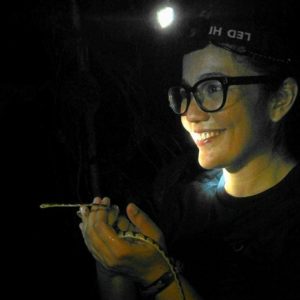
Luciana Frazão is a biologist (UFAM), master in zoology (MPEG /UFPA), and doctor in Biodiversity and Conservation (PPG-BIONORTE ). Currently she works at the Centro Nacional de Pesquisa e Conservação da Biodiversidade Amazônica - CEPAM/ICMBio,where she helps in the execution of National Plans for the Conservation of Endangered Species - PANs.
More information on Lattes and ResearchGate.

